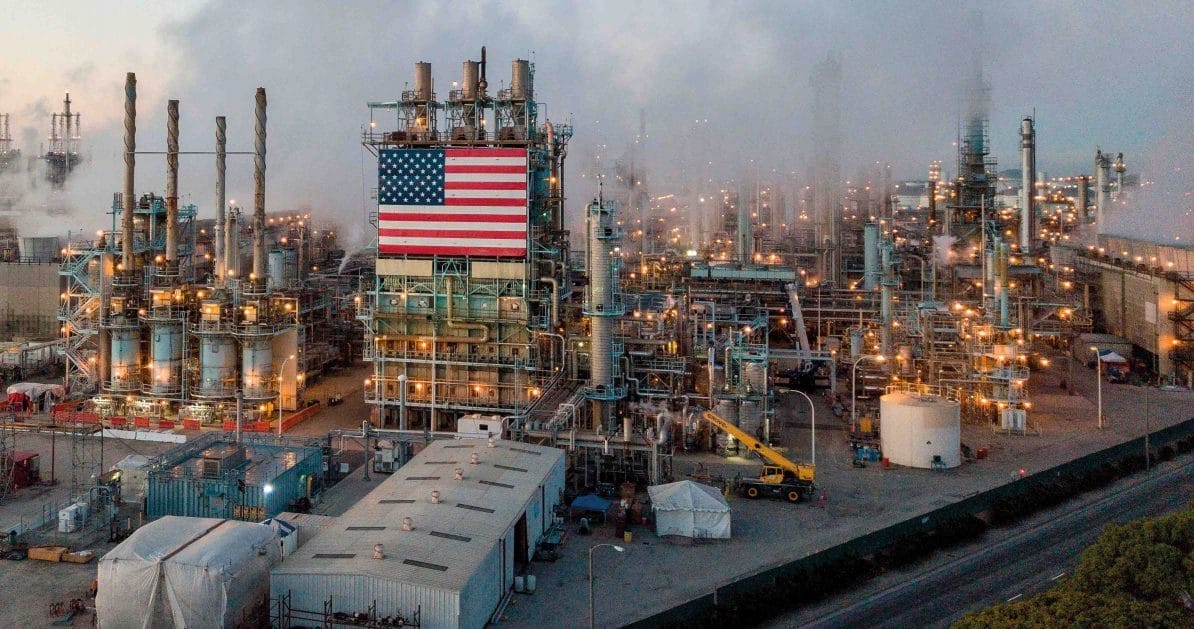Moment that mattered: US oil prices turn negative
In 2020 we spoke to Pulitzer-winning author and energy expert Daniel Yergin about the day the price of oil plunged into negative territory for the first time

The Los Angeles Refinery in Carson, California, can produce 363,000 barrels of crude oil a day. Photo: Robyn Beck/AFP
20th April 2020 (Taken from: #39)
On 20th April US oil prices went negative for the first time in history, briefly falling to -$37.63 per barrel. From being worth over $60 a barrel in January, oil was – for a short time – something you had to pay people to take away. “It was a shock, yes, but it really was a one off,” says 73-year-old Daniel Yergin, an energy expert whose book about the global oil industry, The Prize, won a Pulitzer in 1992. “The oil supply was building up and there was no way to get it into storage or into pipelines because everything was filled up.” There were winners as well as losers. One London-based trading house, BB Energy, was able to purchase 250,000 barrels of crude at a sub-zero price because they, and almost nobody else, had access to storage facilities.
Although the surreal plunge was short-lived, there’s little doubt that the global oil industry is in the midst of a crisis. Even before the Covid-19 pandemic there was too little demand and too much supply, in part a consequence of the shale revolution in the US. The ability to capture trapped oil and gas from underground rock layers through fracking more than doubled the country’s output and reduced its dependence on oil imports. And then the virus appeared.
“During the first phase of the crisis, when China shut down, people used the word ‘unprecedented’ because it took a significant chunk out of world oil demand,” says Yergin, who is also vice-chairman of IHS Markit, a London-based research firm. “But then we also had the shutdown in Europe and North America. This took more than a quarter of the world’s oil demand away and that gave a whole new meaning to the word. Nothing like this had ever happened in the history of the world… I knew there would be periods of weakness with supply and demand. But there was no anticipation of a virus that would be so transmissible and serious.”
It was a shock, yes, but it really was a one off”
The collapse has already made some significant geopolitical waves. Saudi Arabia and Russia, the second and third biggest oil-producing countries respectively, ended years of cooperation and became embroiled in an oil price war in early March when Moscow refused to cooperate with Riyadh over planned production cuts in response to the global shutdown. The Kingdom retaliated by dropping its export prices. The already troubled global oil market went into freefall, with billions of dollars wiped off the share prices of the world’s major oil producers. A truce was finally reached on 12th April when the US government brokered a deal between the Opec cartel of oil producing nations and its allies to reduce oil output by around 10 percent.
While the Saudi-Russia price war had a detrimental short-term impact on the oil industry, the climate crisis poses a more serious long-term challenge. On 12th February, British oil giant BP announced a plan to reduce its carbon footprint to net-zero by 2050. Three month later its chief executive, Bernard Looney, said that the collapse of global energy markets caused by the pandemic had left him “more convinced than ever” that his company needed to invest more in green energy. Other international oil companies including British-Dutch multinational Shell and French oil giant Total have articulated similar goals, embracing what Yergin refers to as the “energy transition”: the shift away from a world that depends on oil, natural gas and coal to one which largely operates on renewable energy sources such as wind and solar power.
However, Yergin still believes that this change will be gradual rather than sudden. “Energy transition is nothing new,” says Yergin. “I date the beginning of the first energy transition to 1709, in a village called Coldbrook Dale in England, where a metal worker found that he could produce iron more easily with coal rather than wood. It’s been happening a long time and we’re in one now. Europe has very ambitious goals, as does Britain, but when you look at the numbers involved you see that this is something that will unfold over decades, not in a decade. I mean, 84 percent of world energy [still] comes from oil, natural gas and coal.”
Yergin cites another reason why a major global transition towards renewable energy may take longer than many people hope. “The technologies aren’t there yet; wind and solar don’t replace oil, they don’t replace the petrol in your car.” However, he does point to three breakthrough technologies that could help us reach net-zero: hydrogen, which has the potential to supply around 10 percent of global energy requirements; major advances in battery technology; and carbon capture technologies, which see carbon dioxide emissions trapped before they enter the atmosphere. “One of the most important things for the ‘energy transition’ is governments,” Yergin adds. “If they really want to know where to invest, it’s in science and research.”
Although the future is likely to be tough for the oil industry – Yergin expects to see a wave of bankruptcies and consolidation among smaller players in the US – he thinks that it’s too early to declare that the oil age is over. “The expectation I express in my new book [The New Map: Energy, Climate, and the Clash of Nations] is that most probably the peak in oil demand comes some time in the first half of the 2030s and then sort of slopes down.”
The technologies aren’t there yet; wind and solar don’t replace oil, they don’t replace the petrol in your car”
The pandemic’s impact on our lifestyles may have an effect on oil demand. “Five years of advances in digitalisation have been compressed into five months and people have discovered that you can work at home and be very productive and not commute,” says Yergin. But the new normal won’t necessarily result in a fall in demand. “In China, oil demand is actually higher than it was last year and one reason is because people are driving because they don’t want to go on public transportation.” He also stresses that the demand for oil isn’t just about transport. “Around 20 percent of the world’s oil demand goes into things like plastics. It goes into all the tools and equipment that’s used in a hospital operating room. It goes into medicines. Does this lost year of 2020 somehow move the peak closer? I think that judgement is way too premature.”
In August, US oil giant ExxonMobil lost its place in the Dow Jones Industrial Average, an index that tracks the stocks of 30 of the largest US companies, suggesting that big oil simply isn’t that big any more. But despite this symbolic blow to the industry and its brief spell as the commodity you couldn’t give away, oil appears to have some life in it yet. On 5th August prices rose above $45 a barrel for the first time since the start of the pandemic. “Oil prices collapsed pretty fast but they’ve come back pretty fast, too,” says Yergin. “It remains the fuel that lubricates global commerce. In terms of transportation, in terms of global trade, it’s still the case that oil makes the world go round.”
Slow Journalism in your inbox, plus infographics, offers and more: sign up for the free DG newsletter. Sign me up
Thanks for signing up.








